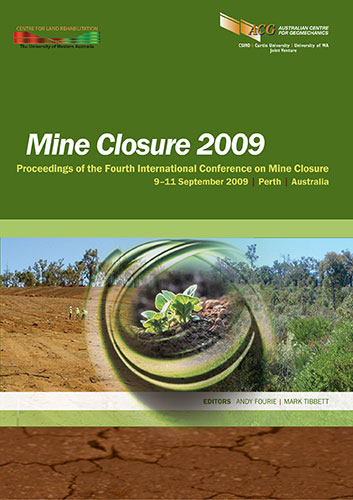Transition of a major tailings facility in a sensitive environment — from operation to decommissioning at Brenda Mine

|
Authors: Lo, RC; Stroiazzo, J; Guilleminot, G |
DOI https://doi.org/10.36487/ACG_repo/908_16
Cite As:
Lo, RC, Stroiazzo, J & Guilleminot, G 2009, 'Transition of a major tailings facility in a sensitive environment — from operation to decommissioning at Brenda Mine', in AB Fourie & M Tibbett (eds), Mine Closure 2009: Proceedings of the Fourth International Conference on Mine Closure, Australian Centre for Geomechanics, Perth, pp. 229-243, https://doi.org/10.36487/ACG_repo/908_16
Abstract:
The Brenda Mine closure plan had been developed in consultation with regulators and stakeholders. Reclamation work at the mine was carried out whenever practical, while the mine was still in operation prior to 1990. Additional reclamation work continues to date. The molybdenum-related geochemical issue played a dominant role in the adopted closure scheme. To mitigate the impact of mine-site molybdenum- bearing water on the quality of water in the surrounding environment, a water treatment plant, with a maximum installed treatment capacity of 313 l/s was constructed. With the plant starting operation in 1998, excess molybdenum-bearing water stored in the tailings pond and pit lake, has been treated in the plant and released on a scheduled annual basis under permit. Ongoing monitoring of surface and groundwater quality at control locations has been carried out to confirm compliance of permit conditions. This paper describes how site water management has become the key to successful decommissioning at Brenda Mine. It covers all man-made landforms within the mine proper related to water management need. Moreover, the long-term dam safety aspect of the two key tailings dams are discussed in light of their design and construction history.
References:
Agra Earth and Environmental Ltd (Agra) (1999) Brenda Mine Closure Project – Saddle Dam – Emergency Discharge
Structure, Internal report (unpublished).
Agra Earth and Environmental Ltd (Agra) (1998a) Brenda Mine Closure – Long Term Runoff Management System
Design, Internal report (unpublished).
Agra Earth and Environmental Ltd (Agra) (1998b) Polishing Pond – As-Built Report, Internal report (unpublished).
Amec (2007) Inspection of the Flooding Event from the East Rock Pile, Internal report (unpublished).
Amec (2003) Brenda 2003 Hydrologic Model, Internal report (unpublished).
Amec (2002) Brenda Mines – Phase 1 Sludge Disposal Facility – Detailed Design, Internal report (unpublished).
Amec (2001) Brenda Pit Area – Review of Groundwater Monitoring Results, Internal report (unpublished).
Aubé, B.C. and Stroiazzo, J. (2000) Molybdenum Treatment at Brenda Mines, Proc. of 5th International Conference on
Acid Rock Drainage, Society for Mining, Metallurgy, and Exploration (SME), Denver, Colorado.
British Columbia Ministry of Environment Lands and Parks (BCMELP) (2003) Permit PE-00263 (last amended on May
27, 2003), British Columbia Ministry of Environment Lands and Parks (now Ministry of Environment).
British Columbia Ministry of Energy, Mines and Petroleum Resources (BCEMPR) (2002) Permit M-12 (last amended
on May 10, 2002), British Columbia Ministry of Energy, Mines and Petroleum Resources.
Golder Associates Ltd (1998) Review of Long-term Pit Slope Stability, Internal report (unpublished).
Klohn Crippen Consultants Ltd (1998) Open Pit Hydrogeology, Internal report (unpublished).
Klohn, E.J. (1984) The Brenda Mines’ Cycloned-Sand Tailings Dam, Proc. of 1st
International Conference on Case
Histories in Geotechnical Engineering, May, pp. 953–977.
Stanley Associates Engineering Ltd (Stanley) (1995) Water Management Master Plan for the Brenda Mine Site, Internal
report (unpublished).
Steffen Robertson and Kirsten (Canada) Inc. (SRK) (1992) Mathematical Modelling of Molybdenum Leaching from the
Brenda Mine Rock Piles, Internal report (unpublished).
Steffen Robertson and Kirsten (Canada) Inc. (SRK), Rescan Environmental Services Ltd, C.E. Jones and Associates Ltd
and H.M. Larratt Aquatic Consulting Ltd (1993) Brenda Mine Decommissioning Plan, Internal report
(unpublished).
© Copyright 2026, Australian Centre for Geomechanics (ACG), The University of Western Australia. All rights reserved.
View copyright/legal information
Please direct any queries or error reports to repository-acg@uwa.edu.au
View copyright/legal information
Please direct any queries or error reports to repository-acg@uwa.edu.au